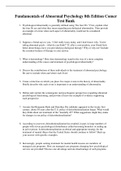Fundamentals of Abnormal Psychology 8th Edition Comer
Test Bank
1. Psychological abnormality is generally defined using “the four D's.” First, explain what
the four Ds are and what they mean regarding psychological abnormality. Then provide
an example of a time when each aspect of abnormality would not be considered
abnormal.
2. Suppose a friend says to you, “I feel really lousy today, and I don't know why. You're
taking abnormal psych—what do you think?” If, after a conversation, your friend feels
better about things, have you provided psychological therapy? Why or why not? Include
the essential features of therapy in your answer.
3. What is demonology? How does demonology stand in the way of a more complete
understanding of the causes and treatment of psychological abnormality?
4. Discuss the contributions of three individuals to the treatment of abnormal psychology.
Be sure to include when and where each lived.
5. Create a time line on which you place five major events in the history of abnormality.
Briefly describe why each event is important to an understanding of abnormality.
6. Define and contrast the somatogenic and psychogenic perspectives regarding abnormal
psychological functioning, and provide at least one example of evidence supporting
each perspective.
7. Assume that Benjamin Rush and Dorothea Dix suddenly appeared in the twenty-first
century, about 50 years after the U.S. policy of deinstitutionalization began. What would
they think about our treatment of the “mentally ill”? What suggestions might they make
for changes in our policy of deinstitutionalization?
8. According to your text, deinstitutionalization has resulted, in part, in large numbers of
people with severe psychological disturbances either becoming homeless or ending up
in jail or prison. Is deinstitutionalization an ethical and appropriate strategy for the
treatment of mental illness that the United States should continue to follow? Back up
your answer with specific examples.
9. Increasingly, people seeking treatment for mental health reasons are members of
managed care programs. How are managed care programs changing how psychological
services are provided? Discuss one advantage and one disadvantage of such programs.
,10. Clinical psychologists, psychiatrists, and clinical researchers are mental health
professionals that work in the area of psychological abnormality. Describe what each
does and how they differ from each other.
11. What are important differences between case studies and single-subject experiments? Be
sure to mention advantages and disadvantages of each.
12. Case studies can be used to help more than just the one being studied. Briefly describe
three ways one could use information gathered from a case study besides helping the
one being studied.
13. Describe three hypothetical correlations: positive correlations, negative correlations, and
unrelated correlations, and give an example for each.
14. A major shortcoming of a correlational study is that even when a correlation between
two variables is statistically significant, one cannot infer causation. For example, a
significant correlation exists between life stress and depression, yet one cannot say for
sure that life stress causes depression. Given this major shortcoming, what are some
specific reasons one might still wish to conduct a correlational study, as opposed to an
experimental study (from which one might infer a cause-and-effect relationship)?
15. Assume that a researcher wishes to do research designed to pinpoint early-childhood
events related to later development of eating disorders such as anorexia nervosa. What
type of investigation might the researcher use? What would be potential strengths and
weaknesses of that type of investigation? Finally, are there any ethical concerns the
researcher ought to address?
16. Design an experiment to test the hypothesis that older women who take estrogen are less
likely to develop Alzheimer's disease. Be sure to identify the control group,
experimental group, independent variable, and dependent variable.
17. A researcher wishes to use experimentation to study the effect of stress on the
development of abnormal behaviors. Describe how the researcher might conduct that
study, using either natural or analogue experiments.
,Answer Key
1. There are said to be four “Ds” of psychological abnormality.
The first is “deviance,” which describes abnormal behavior, thoughts, and emotions that
differ markedly from society's ideas about proper functioning. An example of deviance
that would not be considered abnormal is a person who sleeps outside when camping.
While sleeping outdoors is not the norm in our society, we make exception for this
behavior under this specific circumstance.
The second is “distress.” When an individual feels distress over symptom manifestation,
we often consider this a marker of abnormality. An example of when distress would not
be considered abnormal would be a situation in which a parent experiences distress
because his or her child is serving in the military in a war zone. The feelings of distress
inherent in a daughter or son serving abroad would not be enough to label someone as
abnormal in functioning.
The third element in psychological abnormality is “dysfunction.” Abnormal behavior
tends to be considered dysfunctional when it interrupts the ability to function in daily
living. An example of when dysfunction would not be considered abnormal would be if
someone voluntarily engaged in a hunger strike out of protest. Often these individuals
are considered heroic rather than dysfunctional.
The final element is “danger,” which is usually classified as an individual being a
danger or threat to him- or herself or others. An example of when dangerousness would
not be considered abnormal could be during times of military service in combat.
Individuals in combat are sometimes called on to harm others, and in acts considered
heroic, some soldiers sacrifice their own lives for the safety of their group.
2. According to my text, I have not provided psychological therapy. Clinical theorist
Jerome Frank stated that all therapy has three essential features. One is a sufferer who
seeks relief from the healer. The second feature of true therapy is that it must be
administered by a trained, socially accepted healer who has expertise in what the
individual struggles with. The third essential element of therapy is that there should be a
series of contacts with the sufferer to produce changes. In this example the second and
third criteria have not been satisfied. As such, psychological therapy has not taken place.
3. Demonology is the view that psychological dysfunction was caused by Satan's
influence. In Europe during the Middle Ages, members of the clergy had great power,
and their religious beliefs and explanations dominated education and culture. Due to its
influence, the Church controlled how psychological phenomena were interpreted, and
alternative scientific explanations were dismissed.
4. Answers may include any of the following, or other figures discussed in the text:
Hippocrates: 460–377 B.C. Greece. Referred to as the father of modern medicine,
Hippocrates contributed the belief that illnesses had natural causes, and he saw abnormal
behavior as arising from physical problems.
, Emil Kraepelin: 1856–1926. Germany. Kraepelin was a German researcher who published a
textbook in 1883 stating that physical factors such as fatigue were responsible for mental
dysfunction. He also developed the first modern system for classifying abnormal behavior
using symptoms, as we do today.
Dorothea Dix: 1802–1887. Boston, Massachusetts, U.S. Dix was a schoolteacher who called
for mental health treatment reform by speaking to both state legislatures and the U.S.
Congress about the horrors she witnessed at asylums. Her campaign led to improved laws
and funding, specifically to set up state hospitals to care for the mentally ill.
Philippe Pinel: 1745–1826. Paris, France. Pinel argued that the mentally ill should be treated
with sympathy and kindness, and, after becoming chief physician at La Bicêtre, unchained
patients and renovated rooms to reflect his perspective.
Friedrich Anton Mesmer: 1734–1815. Mesmer was an Austrian physician who set up a clinic
in Paris. He used hypnotism to heal those with hysterical disorders, showing that a person
sometimes holds the keys for healing him- or herself. Mesmer's hypnotism paved the way for
later psychoanalytic explanations using the unconscious.
Benjamin Rush: 1745–1813. Pennsylvania, U.S. Considered the father of American
psychiatry, Rush developed humane treatment approaches to mental illness, even hiring
sensitive attendants to work with patients he treated.
William Tuke: 1732–1819. England. Tuke founded a rural retreat for those with mental
illness using methods of rest, talk, prayer, and work to assist healing. His moral treatment
inspired others, such as Benjamin Rush, to treat patients humanely and with respect.
5. The five major events in the history of abnormality in the order of their occurrence
would be:
1. Demonology. The belief that evil spirits or dark forces created psychological
dysfunction permeated the belief about mentally ill individuals and their treatment for
years. Demonology led to some of the greatest atrocities committed against those who
were mentally ill and may still be a factor in the stigma many feel against the mentally
ill today. Our text, for example, notes that 43 percent of people still believe that those
with mental illness have brought it on themselves.
2. The Rise of Asylums. The unspeakably cruel ways in which the mentally ill have
been treated should not be forgotten. The asylums began with good intentions but
eventually became a national shame. Asylums reflect the ways in which we viewed
those who struggled with mental illness.
3. Moral Treatment. Figures such as Tuke, Pinel, Rush, and Dix were essential to
revolutionizing the way in which those who struggled with mental illness were treated
and represent a turning point in the history of how those with mental dysfunction were
viewed and treated. By framing mental dysfunction as an illness to be treated, it set the
stage for those like Freud to develop theories that framed clients and their treatments
with humanity.
4. The Advent of Psychotropic Medications. When individuals with mental dysfunctions
were institutionalized, even with humane practices, there were many who could not be
helped because the nature of their illness was so inherently biological. Psychotropic
medication allowed many to function outside of an institutional setting who may never
have had a chance of recovery otherwise. Psychotropic medications of the past also
solidified the status of mental illness as a treatable and often biologically based illness.
5. Deinstitutionalization. The final inclusion of deinstitutionalization is present because





